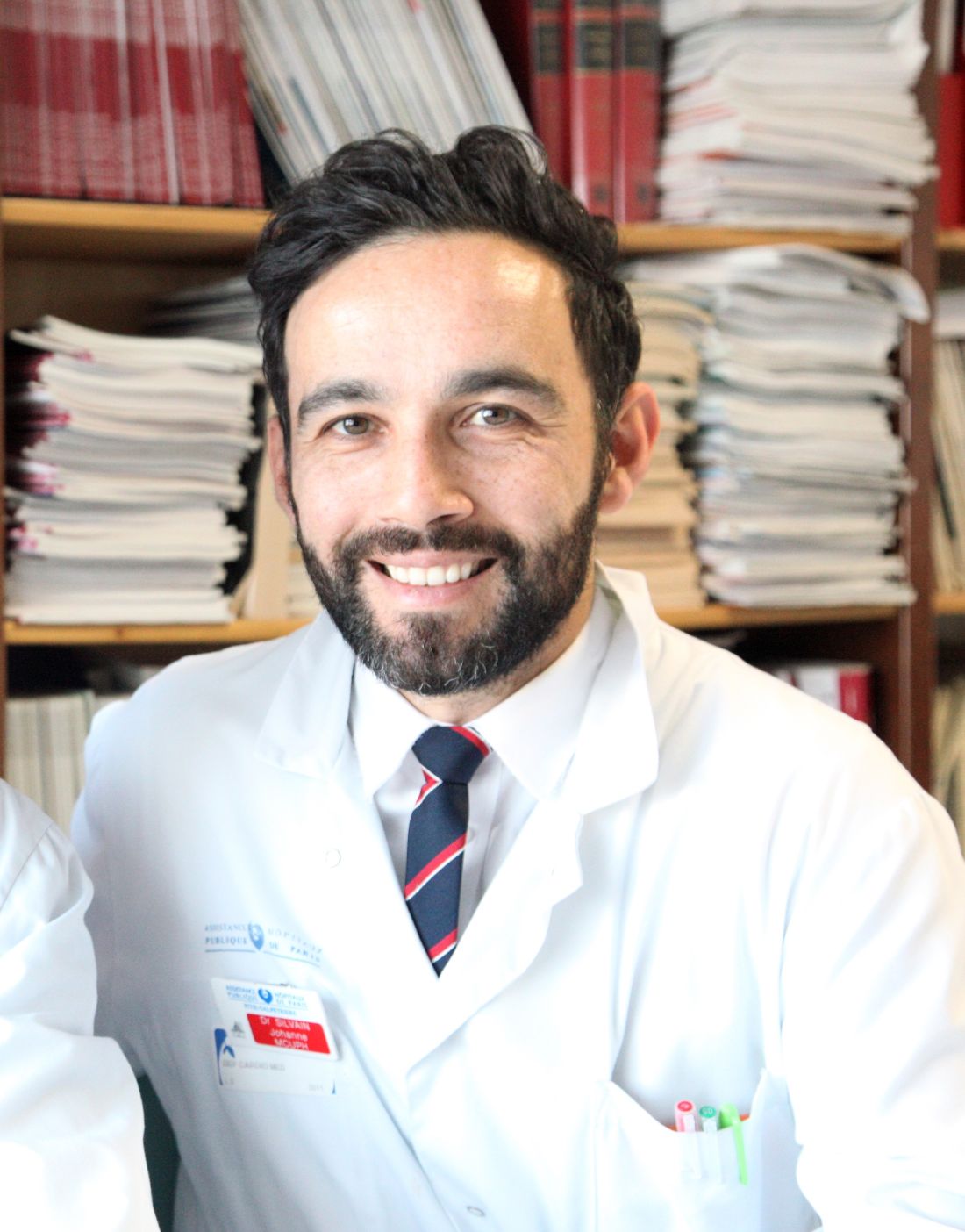User login
Ticagrelor failed to unseat clopidogrel as the guideline-recommended P2Y12 inhibitor of choice in patients undergoing elective percutaneous coronary intervention for stable CAD in the randomized ALPHEUS trial.
“The higher level of platelet inhibition obtained with ticagrelor does not translate into a reduction of periprocedural MI or myocardial injury within 48 hours of high-risk PCI performed in stable coronary patients,” reported Johanne Silvain, MD, PhD, professor of cardiology at the Sorbonne University and director of the ICU at Pitie-Salpetriere Hospital, Paris, at the virtual American Heart Association scientific sessions.
Ticagrelor did, however, result in a significantly higher rate of nuisance or minor bleeding than clopidogrel within 30 days post PCI, as well as more frequent dyspnea and treatment discontinuation.
ALPHEUS was an open-label, randomized trial including 1,883 patients undergoing elective PCI for stable coronary disease at 49 French or Czech PCI centers. All participants were either troponin-negative or had a modestly elevated but declining high-sensitivity troponin level. They possessed an average of 3.2 procedure-related or patient-related high-risk features, among the most common of which were multivessel disease, long lesions requiring multiple stents, and diabetes. Patients were randomized to a 300- or 600-mg loading dose of clopidogrel (Kengreal) or 180 mg of ticagrelor (Brilinta) prior to PCI. Afterwards they continued on 90 mg of ticagrelor twice daily or 75 mg of clopidogrel once daily for 30 days. Everyone was also on aspirin.
Myonecrosis hypothesis falls flat
The primary endpoint was the occurrence of major myocardial injury, defined as a periprocedural troponin elevated greater than 5 times the upper limit of normal within 48 hours of PCI; type 4a MI, defined as major myocardial injury plus signs or symptoms of ischemia; or stent thrombosis.
The rates were closely similar: 35.5% with ticagrelor, 36.2% with clopidogrel. The bulk of events consisted of major myocardial injury, with an incidence of 26.7% in the ticagrelor group and 27.7% with clopidogrel. Stent thrombosis occurred in 0.3% of patients in each group. Type 4a MI occurred in 8.5% of the ticagrelor group and 8.2% of patients on clopidogrel.
The study hypothesis was that a substantial portion of periprocedural myonecrosis may be thrombotic in nature, and that a stronger P2Y12 inhibitor could reduce the occurrence of these mini-infarcts and thus provide patient benefit. But the hypothesis was not borne out.
“We don’t know if these events are a risk factor or just a marker of risk,” Dr. Silvain said.
There were no between-group differences in major bleeding events at 48 hours or 30 days. However, the rate of nuisance or minor bleeding at 30 days was 11.2% in the ticagrelor arm, significantly higher than the 7.5% incidence with clopidogrel. Moreover, dyspnea occurred in 11.2% of patients on ticagrelor, compared to 0.2% with clopidogrel. Study drug discontinuation was more frequent in the ticagrelor arm: 2.2%, versus 0.4%.
Dr. Silvain also presented a pooled analysis of the 1,883 patients in ALPHEUS plus 781 from the similarly designed SASSICAIA trial, which compared prasugrel (Effient) to clopidogrel. Neither of the more potent P2Y12 inhibitors showed superiority over clopidogrel.
Discussant Stephen D. Wiviott, MD, summed things up: “With no evidence for ischemic benefit and higher rates of low-severity bleeding, this trial does not support the use of more potent P2Y12 antagonists for elective PCI. Based on these results, and consistent with SASSICAIA, aspirin with clopidogrel should remain the standard of care in this population.”
Troponin response may vary
A striking finding in ALPHEUS was the discrepancy between very high rates of periprocedural troponin elevation and very low rates of clinical events through 30 days of follow-up. “When you look at these modest elevations of troponin it appears that there is a lot of noise here,” said Dr. Wiviott, vice president for clinical trials research and administration at Massachusetts General Hospital and Brigham and Women’s Hospital and a cardiologist at Harvard Medical School, Boston.
Troponin elevations in stable coronary patients undergoing PCI may have a different underlying mechanism than elevated troponins in patients undergoing PCI for an acute coronary syndrome, he added. In stable CAD patients, the phenomenon may be more related to atherosclerosis than to platelet activation and thrombosis.
During a panel discussion, Sunil V. Rao, MD, said cardiologists are “probably going to have to go back to the drawing board and think about what kinds of events are really, really important.”
“It’s incumbent on our profession to figure out whether periprocedural MI should continue to be a component of the composite endpoint in PCI trials, because it’s highly dependent on the definition that’s being used,” observed Dr. Rao, professor of medicine at Duke University, Durham, N.C.
Dr. Silvain reported receiving institutional research funding and consulting fees from AstraZeneca, which funded the ALPHEUS trial. He serves as a consultant to a handful of other pharmaceutical companies as well.
Simultaneously with Dr. Silvain’s presentation at AHA 2020, the ALPHEUS results were published online in The Lancet.
SOURCE: Silvain J. AHA 2020. Session LBS 3.
Ticagrelor failed to unseat clopidogrel as the guideline-recommended P2Y12 inhibitor of choice in patients undergoing elective percutaneous coronary intervention for stable CAD in the randomized ALPHEUS trial.
“The higher level of platelet inhibition obtained with ticagrelor does not translate into a reduction of periprocedural MI or myocardial injury within 48 hours of high-risk PCI performed in stable coronary patients,” reported Johanne Silvain, MD, PhD, professor of cardiology at the Sorbonne University and director of the ICU at Pitie-Salpetriere Hospital, Paris, at the virtual American Heart Association scientific sessions.
Ticagrelor did, however, result in a significantly higher rate of nuisance or minor bleeding than clopidogrel within 30 days post PCI, as well as more frequent dyspnea and treatment discontinuation.
ALPHEUS was an open-label, randomized trial including 1,883 patients undergoing elective PCI for stable coronary disease at 49 French or Czech PCI centers. All participants were either troponin-negative or had a modestly elevated but declining high-sensitivity troponin level. They possessed an average of 3.2 procedure-related or patient-related high-risk features, among the most common of which were multivessel disease, long lesions requiring multiple stents, and diabetes. Patients were randomized to a 300- or 600-mg loading dose of clopidogrel (Kengreal) or 180 mg of ticagrelor (Brilinta) prior to PCI. Afterwards they continued on 90 mg of ticagrelor twice daily or 75 mg of clopidogrel once daily for 30 days. Everyone was also on aspirin.
Myonecrosis hypothesis falls flat
The primary endpoint was the occurrence of major myocardial injury, defined as a periprocedural troponin elevated greater than 5 times the upper limit of normal within 48 hours of PCI; type 4a MI, defined as major myocardial injury plus signs or symptoms of ischemia; or stent thrombosis.
The rates were closely similar: 35.5% with ticagrelor, 36.2% with clopidogrel. The bulk of events consisted of major myocardial injury, with an incidence of 26.7% in the ticagrelor group and 27.7% with clopidogrel. Stent thrombosis occurred in 0.3% of patients in each group. Type 4a MI occurred in 8.5% of the ticagrelor group and 8.2% of patients on clopidogrel.
The study hypothesis was that a substantial portion of periprocedural myonecrosis may be thrombotic in nature, and that a stronger P2Y12 inhibitor could reduce the occurrence of these mini-infarcts and thus provide patient benefit. But the hypothesis was not borne out.
“We don’t know if these events are a risk factor or just a marker of risk,” Dr. Silvain said.
There were no between-group differences in major bleeding events at 48 hours or 30 days. However, the rate of nuisance or minor bleeding at 30 days was 11.2% in the ticagrelor arm, significantly higher than the 7.5% incidence with clopidogrel. Moreover, dyspnea occurred in 11.2% of patients on ticagrelor, compared to 0.2% with clopidogrel. Study drug discontinuation was more frequent in the ticagrelor arm: 2.2%, versus 0.4%.
Dr. Silvain also presented a pooled analysis of the 1,883 patients in ALPHEUS plus 781 from the similarly designed SASSICAIA trial, which compared prasugrel (Effient) to clopidogrel. Neither of the more potent P2Y12 inhibitors showed superiority over clopidogrel.
Discussant Stephen D. Wiviott, MD, summed things up: “With no evidence for ischemic benefit and higher rates of low-severity bleeding, this trial does not support the use of more potent P2Y12 antagonists for elective PCI. Based on these results, and consistent with SASSICAIA, aspirin with clopidogrel should remain the standard of care in this population.”
Troponin response may vary
A striking finding in ALPHEUS was the discrepancy between very high rates of periprocedural troponin elevation and very low rates of clinical events through 30 days of follow-up. “When you look at these modest elevations of troponin it appears that there is a lot of noise here,” said Dr. Wiviott, vice president for clinical trials research and administration at Massachusetts General Hospital and Brigham and Women’s Hospital and a cardiologist at Harvard Medical School, Boston.
Troponin elevations in stable coronary patients undergoing PCI may have a different underlying mechanism than elevated troponins in patients undergoing PCI for an acute coronary syndrome, he added. In stable CAD patients, the phenomenon may be more related to atherosclerosis than to platelet activation and thrombosis.
During a panel discussion, Sunil V. Rao, MD, said cardiologists are “probably going to have to go back to the drawing board and think about what kinds of events are really, really important.”
“It’s incumbent on our profession to figure out whether periprocedural MI should continue to be a component of the composite endpoint in PCI trials, because it’s highly dependent on the definition that’s being used,” observed Dr. Rao, professor of medicine at Duke University, Durham, N.C.
Dr. Silvain reported receiving institutional research funding and consulting fees from AstraZeneca, which funded the ALPHEUS trial. He serves as a consultant to a handful of other pharmaceutical companies as well.
Simultaneously with Dr. Silvain’s presentation at AHA 2020, the ALPHEUS results were published online in The Lancet.
SOURCE: Silvain J. AHA 2020. Session LBS 3.
Ticagrelor failed to unseat clopidogrel as the guideline-recommended P2Y12 inhibitor of choice in patients undergoing elective percutaneous coronary intervention for stable CAD in the randomized ALPHEUS trial.
“The higher level of platelet inhibition obtained with ticagrelor does not translate into a reduction of periprocedural MI or myocardial injury within 48 hours of high-risk PCI performed in stable coronary patients,” reported Johanne Silvain, MD, PhD, professor of cardiology at the Sorbonne University and director of the ICU at Pitie-Salpetriere Hospital, Paris, at the virtual American Heart Association scientific sessions.
Ticagrelor did, however, result in a significantly higher rate of nuisance or minor bleeding than clopidogrel within 30 days post PCI, as well as more frequent dyspnea and treatment discontinuation.
ALPHEUS was an open-label, randomized trial including 1,883 patients undergoing elective PCI for stable coronary disease at 49 French or Czech PCI centers. All participants were either troponin-negative or had a modestly elevated but declining high-sensitivity troponin level. They possessed an average of 3.2 procedure-related or patient-related high-risk features, among the most common of which were multivessel disease, long lesions requiring multiple stents, and diabetes. Patients were randomized to a 300- or 600-mg loading dose of clopidogrel (Kengreal) or 180 mg of ticagrelor (Brilinta) prior to PCI. Afterwards they continued on 90 mg of ticagrelor twice daily or 75 mg of clopidogrel once daily for 30 days. Everyone was also on aspirin.
Myonecrosis hypothesis falls flat
The primary endpoint was the occurrence of major myocardial injury, defined as a periprocedural troponin elevated greater than 5 times the upper limit of normal within 48 hours of PCI; type 4a MI, defined as major myocardial injury plus signs or symptoms of ischemia; or stent thrombosis.
The rates were closely similar: 35.5% with ticagrelor, 36.2% with clopidogrel. The bulk of events consisted of major myocardial injury, with an incidence of 26.7% in the ticagrelor group and 27.7% with clopidogrel. Stent thrombosis occurred in 0.3% of patients in each group. Type 4a MI occurred in 8.5% of the ticagrelor group and 8.2% of patients on clopidogrel.
The study hypothesis was that a substantial portion of periprocedural myonecrosis may be thrombotic in nature, and that a stronger P2Y12 inhibitor could reduce the occurrence of these mini-infarcts and thus provide patient benefit. But the hypothesis was not borne out.
“We don’t know if these events are a risk factor or just a marker of risk,” Dr. Silvain said.
There were no between-group differences in major bleeding events at 48 hours or 30 days. However, the rate of nuisance or minor bleeding at 30 days was 11.2% in the ticagrelor arm, significantly higher than the 7.5% incidence with clopidogrel. Moreover, dyspnea occurred in 11.2% of patients on ticagrelor, compared to 0.2% with clopidogrel. Study drug discontinuation was more frequent in the ticagrelor arm: 2.2%, versus 0.4%.
Dr. Silvain also presented a pooled analysis of the 1,883 patients in ALPHEUS plus 781 from the similarly designed SASSICAIA trial, which compared prasugrel (Effient) to clopidogrel. Neither of the more potent P2Y12 inhibitors showed superiority over clopidogrel.
Discussant Stephen D. Wiviott, MD, summed things up: “With no evidence for ischemic benefit and higher rates of low-severity bleeding, this trial does not support the use of more potent P2Y12 antagonists for elective PCI. Based on these results, and consistent with SASSICAIA, aspirin with clopidogrel should remain the standard of care in this population.”
Troponin response may vary
A striking finding in ALPHEUS was the discrepancy between very high rates of periprocedural troponin elevation and very low rates of clinical events through 30 days of follow-up. “When you look at these modest elevations of troponin it appears that there is a lot of noise here,” said Dr. Wiviott, vice president for clinical trials research and administration at Massachusetts General Hospital and Brigham and Women’s Hospital and a cardiologist at Harvard Medical School, Boston.
Troponin elevations in stable coronary patients undergoing PCI may have a different underlying mechanism than elevated troponins in patients undergoing PCI for an acute coronary syndrome, he added. In stable CAD patients, the phenomenon may be more related to atherosclerosis than to platelet activation and thrombosis.
During a panel discussion, Sunil V. Rao, MD, said cardiologists are “probably going to have to go back to the drawing board and think about what kinds of events are really, really important.”
“It’s incumbent on our profession to figure out whether periprocedural MI should continue to be a component of the composite endpoint in PCI trials, because it’s highly dependent on the definition that’s being used,” observed Dr. Rao, professor of medicine at Duke University, Durham, N.C.
Dr. Silvain reported receiving institutional research funding and consulting fees from AstraZeneca, which funded the ALPHEUS trial. He serves as a consultant to a handful of other pharmaceutical companies as well.
Simultaneously with Dr. Silvain’s presentation at AHA 2020, the ALPHEUS results were published online in The Lancet.
SOURCE: Silvain J. AHA 2020. Session LBS 3.
REPORTING FROM AHA 2020



